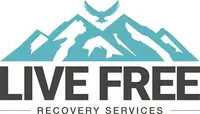Heroin Addiction Treatment in New Hampshire
Heroin addiction can feel like a dead end, but there is a way forward. Live Free Recovery offers expert care, proven therapies, and a place to rebuild with purpose.
What Is Heroin?
Heroin is an illegal opioid made from morphine, which is extracted from poppy plants. It usually appears as a white or brown powder or a sticky black substance known as “black tar.” Street names for heroin include: Smack, H, Junk, Horse, Skag, Brown, Dope, and China White.
Use of heroin spiked in the 1990s and early 2000s, often replacing prescription opioids. Today, it remains one of the most addictive drugs on the street. According to the 2021 National Survey on Drug Use and Health, nearly 1 million people in the US used heroin in the past year.
Heroin Addiction and the Opioid Epidemic
The opioid crisis has reshaped addiction in the US for over two decades. Many people who use heroin started with prescription opioids. The CDC reports that over 75% of drug overdose deaths in 2021 involved an opioid. The rise of fentanyl (a synthetic opioid often mixed with heroin) has made street drugs even more lethal.


The Challenges of Opioid Withdrawal
Opioid withdrawal is exhausting as well as uncomfortable. Symptoms like body aches, restlessness, and insomnia can make quitting feel impossible. It’s often the emotional crash, not just the physical symptoms, that leads people to relapse. Without the right support, it’s hard to push through.
Heroin Effects and Risks
Heroin hijacks the brain’s reward system. It triggers a surge of dopamine, followed by a heavy crash. Over time, the brain stops making dopamine naturally, leaving users stuck in the cycle. Heroin also slows your breathing and heart rate. In high doses, or when laced with fentanyl, this can lead to sudden overdose.
Short-Term Effects
- Euphoria
- Nausea or vomiting
- Drowsiness or nodding off
- Slowed breathing
Long-Term Effects
- Collapsed veins (injection site)
- Liver or kidney disease
- Depression
- Insomnia
Risks of Heroin Use
Using heroin brings a risk of overdose, infection, and death. The danger increases when it’s mixed with fentanyl or other depressants like benzodiazepines.
Common Signs Someone Is Using Heroin
Heroin use can stay hidden until it becomes severe. Knowing what to look for makes early help possible.
Physical signs
- Sudden weight loss
- Tiny (pinpoint) pupils
- Track marks or bruises
- Slurred speech
Psychological signs
- Mood swings
- Apathy
- Anxiety or paranoia
- Difficulty concentrating
Behavioral signs
- Secretive behavior
- Borrowing or stealing money
- Declining hygiene
- Trouble at work or school
What Does Heroin Look Like?
It may appear as a white or brown powder or a black, sticky substance known as black tar heroin.
How Is It Used?
Heroin can be injected, snorted, or smoked. Injection carries a high risk of disease; smoking or snorting still leads to addiction and overdose.
How to Recognize and Respond to a Heroin Overdose
A heroin overdose can cause slow or stopped breathing, blue lips or fingertips, choking sounds, or unconsciousness. If you suspect someone is overdosing, call 911 immediately. Naloxone (Narcan) can reverse an opioid overdose and is widely available at most pharmacies and community programs. If you have it, use it immediately and stay with the person until help arrives.

Heroin Withdrawal Symptoms and Detox Timeline
Withdrawal symptoms can begin within 6 to 12 hours after the last dose and often peak around day 2 or 3. While not often deadly, symptoms can be extremely uncomfortable and emotionally draining.
Early symptoms
- Muscle aches
- Agitation
- Sweating
- Runny nose
Later symptoms
- Nausea and vomiting
- Diarrhea
- Depression
- Intense cravings
How Live Free Recovery Treats Heroin Addiction
At Live Free Recovery, we take a hands-on, human-centered approach to addiction treatment. With gender-specific programming, trauma-informed therapy, and dual diagnosis support, our team is here to help you reclaim your life. We provide structured, compassionate care, starting with detox and continuing through every stage of recovery.
Medical Detox
We offer 24/7 supervised detox to help you withdraw from heroin safely and with as much comfort as possible.
Medication-Assisted Treatment
We use opiate withdrawal medication as part of opioid withdrawal treatment to ease symptoms and reduce cravings during early recovery.
Evidence-Based Therapies and Substance Abuse Counseling

Dual Diagnosis Treatment
Many people battling heroin use also struggle with anxiety, trauma, or depression. Dual diagnosis care treats the addiction and the mental health piece side-by-side, helping reduce relapse risk and improve long-term outcomes.
Our Levels of Care
Inpatient Drug Rehab
In residential care, you’ll live onsite and receive round-the-clock support, daily therapy, and a structured healing environment.
Partial Hospitalization Program (PHP)
Attend a full-day program (5–8 hours) with medical and clinical support, then return home in the evening.
Intensive Outpatient Program (IOP)
Join a part-time treatment schedule (3–4 hours a day, several days per week) that supports your life outside treatment.
Outpatient Drug Rehab
Continue recovery in outpatient care while living at home and attending regular therapy sessions as needed.

Life After Heroin: Building a Sustainable Recovery
Treatment is a beginning, not the finish line. Recovery continues as you re-enter daily life. We help you stay connected to your purpose, with relapse prevention, sober living, and a plan that fits your future.
Get Expert Addiction Treatment at Live Free Recovery
Change takes courage, but you don’t have to do it alone. At Live Free Recovery, you’ll find real people who believe in your recovery and will walk beside you every step of the way. Reach out today. Let’s take the next step together.
FAQs
What does heroin feel like?
It produces a rush of euphoria followed by drowsiness or a “nodding off” sensation. This is part of what makes it highly addictive.
Is heroin an opiate?
Yes. Heroin is a semi-synthetic opioid derived from morphine.
What is black tar heroin?
Black tar heroin is a dark, sticky form of the drug, typically produced in Mexico. It is usually smoked or injected.
Is heroin a depressant?
Yes. Heroin slows down the central nervous system, making it a depressant.
How long does heroin addiction treatment last?
It varies by person and level of care, but treatment typically ranges from 30 to 90 days or longer, depending on your needs.
Can I achieve heroin recovery without going to rehab?
Outpatient programs are available, but heroin addiction often requires more structured care to begin recovery safely.
Can you die from heroin withdrawal?
Withdrawal is usually not fatal, but it can cause serious complications like dehydration or heart problems if unmanaged. Medical detox is the safest way to begin recovery.
